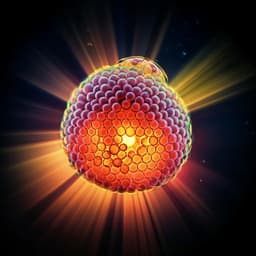
Biology
Minutes-timescale 3D isotropic imaging of entire organs at subcellular resolution by content-aware compressed-sensing light-sheet microscopy
C. Fang, T. Yu, et al.
Explore the groundbreaking work of Chunyu Fang and colleagues as they unveil a revolutionary computational light-sheet microscopy technique, allowing rapid 3D imaging of entire organs at cellular resolution in just minutes! This innovative approach could transform cellular analyses and neuroscience research.
~3 min • Beginner • English
Introduction
Comprehensive understanding of cellular events and their interconnections across whole organs requires 3D high-resolution imaging over mesoscale volumes. Conventional 3D light microscopy has limited optical throughput and depth, often relying on tile stitching and physical sectioning, which increases acquisition time and photobleaching. While integrating light-sheet microscopy (LSM) and tissue clearing improved speed and depth, Gaussian light-sheets face a tradeoff between sheet thickness and field-of-view (FOV), and techniques like ASLM reduce thickness but can cause out-of-waist excitation and photobleaching. Bessel light-sheets offer non-diverging illumination with good axial resolution and lower bleaching but are typically optimized for small, high-NA detection volumes and still constrained by system throughput. Achieving subcellular resolution across entire organs (e.g., mouse brain) requires extremely fine sampling and many tiles, leading to hours-to-days of acquisition. Compressed sensing (CS) can recover higher-quality images from incomplete measurements, but standard CS performance depends on local signal sparsity and noise, which vary widely across large 3D datasets, limiting its applicability. The study addresses these challenges by combining long-range Bessel plane illumination with a 3D content-aware compressed sensing (CACS) reconstruction to enable minutes-scale, isotropic, subcellular imaging of entire organs with high throughput.
Literature Review
Prior approaches include: (1) Confocal and serial two-photon tomography (STPT) can achieve subcellular resolution but require slow point-scanning, mechanical slicing, and extensive stitching, leading to long acquisitions and photobleaching. (2) Gaussian light-sheet microscopy with tissue clearing improves speed, yet Gaussian sheets broaden across large FOVs (e.g., ~7.5 µm FWHM at sheet ends for 1 mm range), limiting axial resolution for fine structures. ASLM extends FOV with thin sheets but introduces out-of-waist excitation and photobleaching; mesoSPIM and ctASLM reported axial resolutions of ~5.5 µm over 3.3 mm FOV and ~0.95 µm over 737 µm FOV, respectively. (3) Bessel LSM produces thin, long sheets with lower photobleaching due to energy concentrated in the central lobe; however, side lobes can excite out-of-focus fluorescence. High-NA detection is typically used to minimize side-lobe effects, focusing on small volumes. Overall, both Gaussian and Bessel LSM face throughput limits set by the system’s space-bandwidth product (SBP), making whole-organ, subcellular-resolution imaging slow. (4) Compressed sensing has been applied to reduce acquisition time or improve SNR but is sensitive to signal sparsity and noise characteristics. Adaptive strategies (e.g., nonlocal TV, Laplacian scale mixtures) help but may underperform in restoring decimated details across heterogeneous large 3D volumes. These limitations motivate a method that combines high-quality, wide, thin illumination with computation that adapts to local content to enhance resolution and contrast efficiently across whole organs.
Methodology
Imaging platform: A zoomable Bessel plane illumination microscope was built. A long Bessel beam is generated using a large-apex axicon to form an annular beam conjugate to a galvanometer and the excitation objective’s rear pupil. The Bessel beam is rapidly swept in y to form a scanned light-sheet at each z-plane. To suppress side-lobe excitation, the scanned Bessel beam is tightly synchronized with a rolling electronic confocal slit on an sCMOS camera (2–4 active pixel rows), substantially reducing background and enabling thin-and-wide illumination (e.g., ~1.6 µm FWHM sheet over ~4×4 mm). Dual-side illumination reduces attenuation/scattering in thick samples. Detection uses a macro-view microscope (Olympus MVX10, ×0.63–6.3 with ×2 objective) providing ×1.26/0.14 to ×12.6/0.5 magnification/NA and an sCMOS camera, yielding FOVs of 1–10 mm and lateral resolution of ~1–10 µm. Illumination objectives (Mitutoyo ×2/0.055, ×5/0.14, ×10/0.28) provide tunable Bessel beams matched to FOV and resolution. Imaging is controlled by LabVIEW, synchronizing a 2D galvo, sCMOS camera, xyz stage, and a flip mirror for dual-side illumination. A custom holder enables high-throughput z-scans and rotation for two-view imaging (0°/180°).
Content-aware compressed sensing (CACS): 3D CS reconstruction is performed in the Fourier domain to exploit signal sparsity. The imaging model uses a measurement matrix A derived from the Fourier transform of the system PSF. The raw large-scale image stack Y is divided into small 3D blocks (e.g., 100×100×100 voxels), each transformed to its Fourier representation y. For each block, two content metrics are computed: α (signal density) and β (inversely related to entropy). The regularization weight λ is calculated as λ=α×β to adaptively balance data fidelity and sparsity according to local signal characteristics. The optimization solved per block is an L1-regularized least squares in Fourier space: minimize ||A x − y||_2 + λ ||x||_1, solved iteratively (interior-point method). Recovered high-resolution tiles x are inverse-transformed to spatial domain and stitched to form the final high-resolution output X. The process is parallelized on multiple GPUs (e.g., 4× RTX 2080 Ti). This unsupervised computation requires no training data.
Acquisition pipelines: For whole-brain imaging (Thy1-GFP-M), the brain (~10×8×5 mm³) is imaged at ×3.2 Bessel sheet (FOV ~4.16 mm) under two opposing views (0° and 180°) with six tiles per view (3×2) at 2 µm z-steps (1500 frames per tile), covering 0–3 mm depth per side; deeper layers are captured from the opposite view. Tiles are stitched per view and the two views are registered and fused (affine model) to yield an 11.4×7.8×5 mm³ volume at 2 µm voxels. CACS subdivides this fused volume into blocks for GPU processing, producing a 0.5-µm iso-voxel reconstruction (3.5 trillion voxels). Acquisition time is ~10 min; CACS compute time is ~5 h using SSD RAID to mitigate I/O.
Comparative imaging: Confocal (×16/0.8), two-photon excitation (×16/0.8), SPIM (0.02 NA illumination with ×3.2/0.28 detection), low-res Bessel (0.14 NA illumination + ×3.2/0.28), high-res Bessel (0.28 NA illumination + ×12.6/0.5), and ×3.2 Bessel with CACS were compared on Thy1-GFP-M samples. Axial/lateral FWHMs, SNR, photobleaching over 30 repeated volumes, and error metrics (NRMSE, SSIM) were evaluated.
Applications and analyses: Whole-brain data were registered to the Allen Brain Atlas (ABA) using an Elastix-based bi-channel pipeline. Quantitative analyses include neuron tracing (Imaris Autopath; NeuroGPS-Tree for dense cortex regions) and cell counting (propidium iodide (PI)-stained half brain) via Imaris Spots/Surface modules to obtain counts and densities per brain region. Dual-color muscle imaging (Thy1-YFP for nerves; α-BTX for motor endplates (MEPs)) quantified MEP numbers, densities, and neuromuscular junction (NMJ) occupancy (presynaptic/postsynaptic volume ratio) from 3D reconstructions. Sample clearing used UDISCO/FDISCO/PEGASOS protocols with matching immersion media; PSFs were measured using 0.5 µm fluorescent beads embedded in refractive-index-matched resin.
Key Findings
- Throughput and resolution: The CACS-enabled Bessel sheet at ×3.2 achieved isotropic ~1.5 µm resolution with an acquisition rate of ~1.5 mm³ s⁻¹, enabling whole-brain (~400 mm³) imaging in ~10 minutes. Post-processing produced 0.5-µm iso-voxels (3.5 trillion voxels) in ~5 hours computation time. The approach expands effective SBP, breaking the conventional light-sheet resolution–speed trade-off.
- Resolution comparisons (measured FWHM on dendrites): Axial FWHM (µm): Gaussian sheet ~15; ×3.2 Bessel ~4.5; ×12.6 Bessel ~1.5; ×3.2 Bessel-CACS ~1.5; confocal ~4.2; TPE ~4.0. Lateral FWHM (µm): Gaussian ~4.5; ×3.2 Bessel ~4.5; ×12.6 Bessel ~1.5; ×3.2 Bessel-CACS ~1.5; confocal ~0.85; TPE ~0.85.
- Recovery fidelity: Compared to ×12.6 Bessel as ground truth, ×3.2 Bessel-CACS yielded NRMSE 3.718 and SSIM 0.855, versus raw ×3.2 Bessel with NRMSE 14.751 and SSIM 0.442.
- Photobleaching over 30 repeated 3D acquisitions (remaining fluorophores): Gaussian ~95%, ×3.2 Bessel ~90%, ×12.6 Bessel ~80%, TPE ~40%, confocal ~30% (normalized for SNR differences).
- Whole-brain pipeline: 12 tiles (6 per view) acquired in ~10 min, fused 2 µm voxel brain volume registered to ABA; CACS produced 0.5-µm iso-voxel brain enabling 3D neuron tracing and region-wise analyses.
- Cell counting in PI-stained half brain: Total cells ~3.3×10^7; average density ~2.4×10^5 cells/mm³. Regional counts (approximate): Isocortex 8.2×10^6; Olfactory area 2.7×10^6; Cerebellum 8.0×10^6; Cortical subplate 4.7×10^5; Cerebral nuclei 3.3×10^6; Hippocampal formation 2.4×10^6; Hypothalamus 1.2×10^6; Midbrain 2.5×10^6; Thalamus 1.3×10^6; Hindbrain 3.3×10^6. Highest density in cerebellum ~4×10^5 cells/mm³.
- Muscle imaging: Dual-color whole-muscle imaging of two gastrocnemius and two tibialis muscles (~720 mm³ total) completed in ~20 min (~5 min per muscle). ×3.2 Bessel-CACS matched ×12.6 Bessel for NMJ structural details, enabling accurate MEP counts/densities and NMJ occupancy (presynaptic/postsynaptic volume ratio) measurements at tissue scale.
- Gigavoxel throughput: Discussion notes gigavoxel-per-second rates up to ~10 gigavoxels/s and broad applicability to large cleared samples.
Discussion
Combining long-range Bessel plane illumination with content-aware compressed sensing enables high-throughput, isotropic, subcellular imaging of entire organs within minutes, directly addressing the throughput and depth limitations of conventional 3D microscopy. The confocal line-synchronized Bessel sheet suppresses side-lobe excitation, providing thin-and-wide sectioning across millimeter-scale FOVs with reduced photobleaching. CACS adapts regularization to local signal density and entropy, enabling recovery from under-sampled, low-NA acquisitions while minimizing artifacts across heterogeneous 3D content. Together, these innovations break the conventional SBP throughput barrier, delivering large FOVs with high isotropic resolution and maintaining low photodamage. The method supports system-level analyses: whole-brain neuron tracing across regions, accurate region-wise cell counting, and tissue-scale NMJ quantification. The approach is unsupervised, training-free, and GPU-accelerated, and can extend to other 3D imaging modalities (confocal, TPEM) to boost effective throughput. Potential improvements include side-lobe-reduced Bessel generation via masking, two-photon excitation for deeper penetration in scattering tissues, and dual-side illumination/detection schemes to further mitigate depletion. The resulting capability to rapidly map entire organs at subcellular resolution may facilitate advances in neuroscience, histology, and pathology, enabling high-throughput, quantitative organ-scale studies.
Conclusion
The study introduces a minutes-timescale, organ-scale imaging platform that merges confocal line-synchronized Bessel light-sheet illumination with content-aware compressed sensing to achieve isotropic ~1.5 µm resolution and high throughput over large FOVs. It enables rapid whole-brain and whole-muscle reconstructions from single acquisitions, supporting detailed neuron tracing, region-resolved cell counting, and NMJ analyses. By adaptively regularizing CS according to local content, the method maintains high fidelity and reduces artifacts across heterogeneous volumes, effectively surpassing conventional light-sheet SBP limits. Future directions include implementing side-lobe-reduced Bessel beams, integrating two-photon excitation for deeper imaging in scattering tissues, expanding dual-view detection to further reduce depletion, and broader application to other 3D microscopy modalities to enhance their throughput.
Limitations
- Dependence on tissue clearing and refractive index matching; current system optimized for solvent-cleared, hardened samples (UDISCO, FDISCO, PEGASOS) and customized holders.
- Depth coverage managed by dual-view acquisition (0–3 mm per side, fused to ~5 mm); very deep/scattering regions beyond optimal clearing may remain challenging.
- Raw acquisitions at low magnification are under-sampled in z (e.g., 2 µm steps), relying on CACS to recover resolution; fidelity depends on local sparsity and content metrics.
- CS limitations for highly complex, dense structures persist; although content-aware regularization mitigates artifacts, recovery may be less accurate for certain morphologies.
- Computational and data I/O demands are substantial (multi-GPU processing, SSD RAID; ~5 h reconstruction; final datasets up to ~2 TB ims files), which may limit accessibility.
- Photobleaching is reduced compared to confocal/TPE but not eliminated; illumination parameters must be balanced with sample integrity.
Related Publications
Explore these studies to deepen your understanding of the subject.







